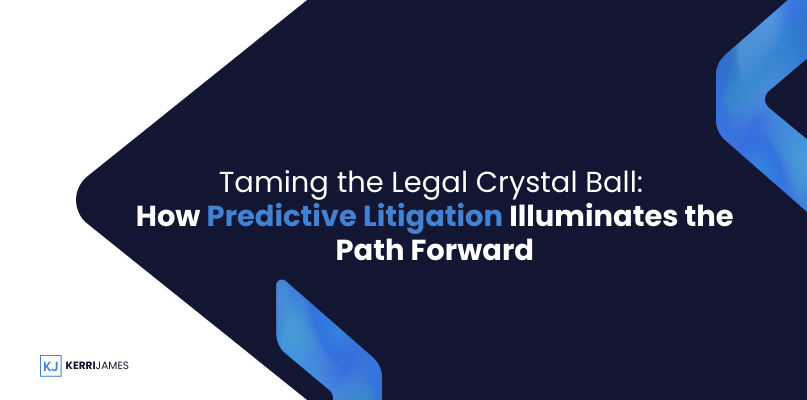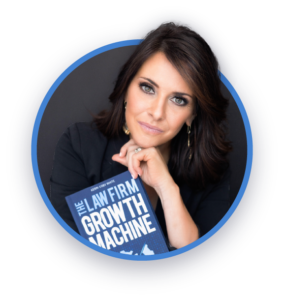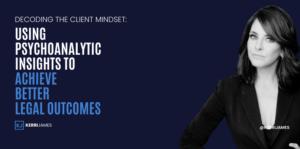Remember that scene in “Minority Report” where Tom Cruise predicts crimes before they happen? While we haven’t quite mastered pre-crime (thank goodness!); there is a burgeoning field in law that’s getting pretty darn close: predictive litigation.
Now, before you picture lawyers huddled around a crystal ball, let me clarify. Predictive litigation isn’t about mystical visions or reading tea leaves. It’s about harnessing the power of data analysis to anticipate potential legal outcomes. Just like Netflix knows what shows you’ll binge next, predictive litigation uses data to unveil patterns, trends, and probabilities within the legal landscape.
Imagine having a tool that could analyze thousands of past cases, identify the factors that led to specific outcomes, and then use that knowledge to predict the likelihood of success in a current case. That’s the power of predictive litigation, and it’s revolutionizing the way we approach the law.
Why Predictive Litigation Matters Now More Than Ever
We live in a data-driven world. Every click, every purchase, every interaction generates a data point, shaping everything from our social media feeds to our credit scores. The legal field, often perceived as traditional and slow to adapt, is now embracing this data revolution.
Predictive litigation offers a significant departure from the reactive, “wait-and-see” approach that has long defined legal practice. It’s about proactively analyzing vast amounts of legal data – verdicts, settlements, judge rulings, even the language used in legal documents – to gain a competitive edge.
Consider these scenarios:
- A corporation is facing a potential class-action lawsuit. Predictive litigation can analyze similar cases, assess the potential financial exposure, and inform the company’s litigation strategy, including whether to settle or fight the case.
- A patent attorney is evaluating the strength of a client’s invention. Predictive litigation can assess the likelihood of obtaining a patent, identify potential infringement risks, and provide data-driven insights to guide the patent application process.
- A family law attorney is helping a couple navigate a complex divorce. Predictive litigation can analyze similar cases to predict the likely division of assets, spousal support payments, and child custody arrangements, empowering the couple to make informed decisions.
These are just a few examples of how predictive litigation is transforming legal practice across various areas of law.
Peering into the Mechanics: How Predictive Litigation Works
Predictive litigation isn’t about replacing brilliant legal minds; it’s about equipping them with powerful tools to augment their expertise. Think of it as a multi-step process that blends legal expertise with data science:
Data Collection: The first step is gathering a vast and diverse set of relevant legal data. This can include:
-
- Court Records: Case filings, dockets, motions, rulings, transcripts, and verdicts from both state and federal courts.
- Legal Databases: Specialized databases containing case law, statutes, regulations, and legal articles.
- Proprietary Law Firm Data: Past case files, client information, billing records, and internal research.
- Publicly Available Information: News articles, social media posts, company websites, and industry reports can provide valuable context.
Data Cleaning and Preparation: Raw data is rarely perfect. It’s often messy, incomplete, and inconsistent. This step involves:
-
- Data Cleansing: Identifying and correcting errors, inconsistencies, and missing values.
- Data Transformation: Converting data into a consistent format for analysis.
- Feature Engineering: Selecting the most relevant variables (features) that are likely to have predictive power.
Model Building: This is where the real magic happens! Data scientists use sophisticated algorithms and machine learning techniques to create predictive models.
-
- Machine Learning: Algorithms that learn patterns and relationships from data without explicit programming. Examples include:
- Regression Analysis: Predicting a continuous outcome (e.g., settlement amount).
- Classification Algorithms: Predicting a categorical outcome (e.g., win or loss).
- Natural Language Processing (NLP): Extracting meaning and insights from text data (e.g., contracts, legal briefs).
- Model Training and Validation: The models are trained on a portion of the data and then tested on a separate dataset to evaluate their accuracy and predictive power.
- Machine Learning: Algorithms that learn patterns and relationships from data without explicit programming. Examples include:
Analysis and Interpretation: This is where legal expertise is paramount. Experienced attorneys analyze the model’s output, considering not only the statistical probabilities but also the nuances of the specific case at hand. They:
-
- Interpret Predictions: Understanding the meaning of the model’s predictions and their implications for the case.
- Identify Key Factors: Determining which variables (e.g., judge’s history, case type, legal arguments) are most influential in driving the predictions.
- Develop Legal Strategies: Using the data-driven insights to inform litigation strategy, settlement negotiations, and risk assessment.
The Benefits of Embracing the Predictive Edge
The benefits of incorporating predictive litigation into legal practice are numerous and impactful:
- Strategic Decision Making: Imagine being able to assess the strengths and weaknesses of your case with data-backed insights. Predictive litigation empowers clients and their attorneys to make informed decisions about:
- Litigation Strategy: Should we pursue an aggressive litigation strategy or opt for a more conciliatory approach?
- Settlement Negotiations: What is a reasonable settlement offer based on similar cases and the predicted likelihood of success at trial?
- Resource Allocation: How much time, money, and manpower should be invested in this case based on its predicted complexity and potential outcomes?
- Cost Optimization: Litigation is notoriously expensive. By identifying potential roadblocks early on, predictive litigation can help:
- Avoid Costly Trials: By providing a realistic assessment of the likely outcome, it can encourage parties to settle out of court, saving significant time and money.
- Focus Resources Efficiently: Law firms can allocate resources more strategically, focusing on cases with a higher probability of success.
- Streamline Legal Research: By quickly identifying relevant case law and precedents, predictive litigation tools can reduce the time spent on legal research.
- Enhanced Client Communication: Transparency and clear communication are crucial in any attorney-client relationship. Predictive litigation fosters trust by:
- Providing Realistic Expectations: Clients can make informed decisions based on data-driven predictions rather than speculation or gut feelings.
- Quantifying Risk: Predictive models can assign probabilities to various outcomes, allowing clients to understand the level of risk involved.
- Facilitating Informed Consent: Clients can provide truly informed consent for legal strategies when they understand the data-backed rationale behind them.
- Competitive Advantage: In the competitive legal arena, embracing innovation can set you apart.
- Attracting Clients: Clients are increasingly seeking tech-savvy lawyers who use cutting-edge tools to achieve better outcomes.
- Recruiting Top Talent: Law students and young lawyers are drawn to firms that are at the forefront of legal technology.
- Improving Efficiency: By automating tasks and providing data-driven insights, predictive litigation allows lawyers to focus on higher-level strategic thinking.
Navigating the Ethical Considerations
With great power comes great responsibility. Predictive litigation, while holding immense promise, also raises important ethical considerations that must be addressed thoughtfully:
- Data Privacy: Protecting sensitive client data is paramount. Law firms and legal tech companies must:
- Implement Robust Security Measures: Encryption, access controls, and data anonymization techniques can safeguard client data.
- Comply with Privacy Regulations: Adhering to laws like GDPR (General Data Protection Regulation) and CCPA (California Consumer Privacy Act) is essential.
- Obtain Informed Consent: Clients must be fully informed about how their data will be used and must provide explicit consent.
- Algorithmic Bias: Algorithms are not inherently neutral; they inherit biases from the data they are trained on. Mitigating bias requires:
- Careful Data Selection: Ensuring that the training data is representative and does not perpetuate existing biases.
- Bias Detection and Mitigation Techniques: Using statistical techniques to identify and correct for bias in algorithms.
- Ongoing Monitoring and Auditing: Regularly evaluating the model’s output to ensure fairness and address any emerging biases.
- Transparency and Explainability: It’s not enough to simply present a prediction; clients deserve to understand the “why” behind it.
- Explainable AI (XAI): Developing models that can provide clear explanations for their predictions, even for complex algorithms.
- Clear Communication: Attorneys must be able to explain the model’s reasoning and limitations to clients in an understandable way.
- Open Dialogue: Fostering an open dialogue between data scientists, lawyers, and clients to address concerns about transparency and potential bias.
- Access to Justice: As with many technologies, there’s a risk that predictive litigation could exacerbate existing inequalities in access to justice.
- Bridging the Affordability Gap: Exploring ways to make these tools accessible to smaller firms, non-profit organizations, and individuals who may not have the resources to invest in expensive technology.
- Promoting Legal Aid Innovation: Encouraging the development and use of predictive litigation tools within legal aid organizations to level the playing field.
- Public Education: Raising awareness about the potential benefits of predictive litigation for all members of society.
The Future is Predictive: A New Era of Data-Driven Law
Predictive litigation isn’t just a technological innovation; it represents a fundamental shift in the legal landscape. As we move further into the age of data, the ability to analyze, interpret, and leverage legal data will be paramount to success.
Imagine a future where:
- Lawyers are as comfortable with data as they are with case law. Legal education will need to adapt to incorporate data science, statistics, and technology into the curriculum. New generations of lawyers will graduate with a deeper understanding of data analysis and its applications in legal practice.
- Courtrooms embrace data-driven insights. Judges may rely on predictive models to assess sentencing guidelines, evaluate bail risks, and even predict the likelihood of recidivism. This could lead to a more objective and evidence-based justice system.
- Legal disputes are resolved more efficiently and fairly. Predictive litigation can encourage early settlements, streamline discovery, and reduce the time and cost of litigation, making the justice system more accessible to all. This shift towards efficiency could also free up court resources to focus on more complex cases that require greater attention.
However, this future is not without its challenges. Addressing the ethical considerations of data privacy, algorithmic bias, and access to justice will be crucial to ensure that predictive litigation is used responsibly and for the benefit of all. Striking a balance between harnessing the power of data and upholding the fundamental principles of justice will be an ongoing challenge.
As we stand at the cusp of this transformative era in law, one thing is clear: the legal profession must embrace data-driven decision-making to remain relevant and effective. Those who adapt, innovate, and prioritize ethical considerations will be the ones who shape the future of law in the years to come. The crystal ball is no longer a mystical artifact but a powerful tool for understanding and navigating the complexities of the legal world. By embracing the potential of predictive litigation while carefully addressing its ethical implications, we can create a more just, efficient, and equitable legal system for all.










